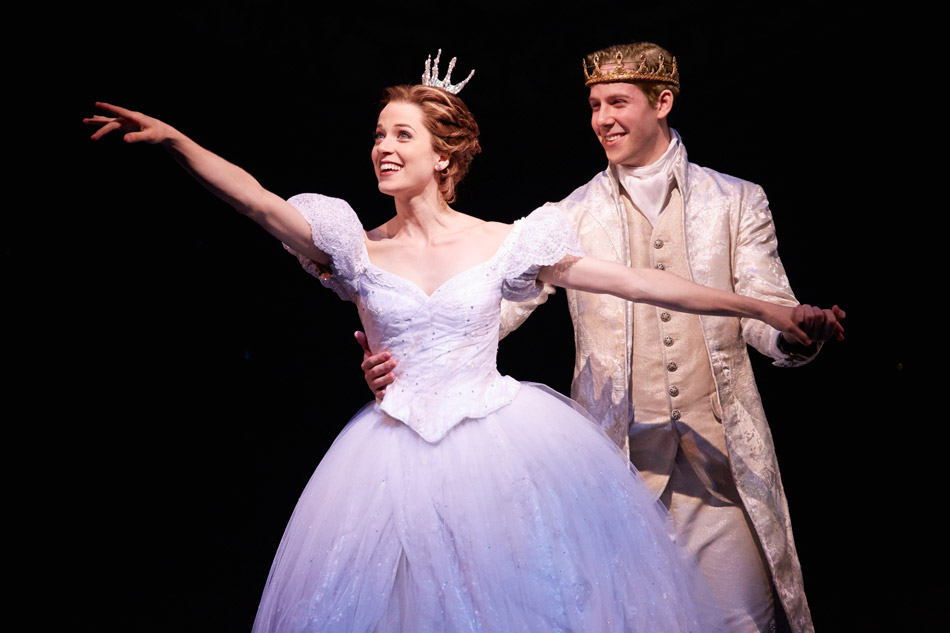 From the moment the audience members stepped into the Auditorium Theatre on Tuesday night, there was magic in the air. Little girls flounced down the aisles in powder blue dresses and tiaras; elderly couples held hands and smiled as they pointed at towering, glittering trees onstage; and grownup girls sat giggling with groups of friends.
From the moment the audience members stepped into the Auditorium Theatre on Tuesday night, there was magic in the air. Little girls flounced down the aisles in powder blue dresses and tiaras; elderly couples held hands and smiled as they pointed at towering, glittering trees onstage; and grownup girls sat giggling with groups of friends.
As the lights dimmed and the familiar overture began, there may have been a few voices humming along—this is Cinderella after all, a classic musical that first appeared on TV in 1957 with the inimitable Julie Andrews in the leading role. The fairy tale had a bit of an upgrade in January 2013, and this new version’s book (penned by Douglas Carter Beane) has some unexpected turns, all while retaining the same beloved songs.
Without giving away too much of the “new” plot (also read: go see the show before it’s gone), it’s possible to discuss the most striking transformation in this version. It’s not the colloquial language (there’s some of that, ser-i-ously, especially from ‘Madame’ stepmother and the stepsisters) or the added/subtracted characters (in a Disney-esque plot twist, Prince Charming/Topher’s parents are deceased in this version).
But the most remarkable updates are made to the character of Cinderella herself, a tricky task when you’re dealing with one of the most popular princesses of all time. This Cinderella is independent. She’s kind. She’s tough—oh, and she’s well-versed in public diplomacy. Sound a little feminist for “once upon a time” and “happily ever after” stories? Maybe in the traditional sense. But we live in an age where girls reject pink Lego sets and code websites. A world where they’re independent and that’s encouraged. Somehow, this plot has all the right components to leave little (and big) girls feeling like they don’t need a prince to ride in on his white horse—but they can want him and still be strong. And they can be smart. (In fact, the show’s writer may have taken a cue from Kate Middleton’s example of how to be a modern day princess.)
The show is further successful due to a cast filled with triple threats: dancer/singer/actors. This is the new version’s first national tour, and Paige Faure (Cinderella) previously played the role on Broadway. It’s a good thing she’s touring, because theater lovers across the states who can’t make it to Broadway can now be delighted by her clever acting, graceful dancing, and sweet, powerful voice. This is a true leading lady, and she shares a wonderful onstage chemistry with the awkward, adorable Andy Jones (Prince Topher), who has a pretty decent set of pipes himself.
The loudest cheer during Tuesday’s bows was for Kecia Lewis (Marie/Fairy Godmother), who’s not only the cast member you want to gossip with and befriend, but the singer of the night’s most magical song, “Impossible/It’s Possible,” during which she and Faure handled a technical difficulty with a classy sense of humor. The rest of the cast—notably stepsisters Charlotte (Aimee Garcia) and Gabrielle (Ashley Park) and Stepmother/Madame (Beth Glover) makes the show even more enjoyable with soaring vocals and toe-tapping dance numbers.
Add to that a pinch of costume-related special effects that left everyone blinking in amazement (OK, how did they transform Ella’s gowns so fast?) and whimsical scenic design by Anna Louizos, and Cinderella is a show that still delights, no matter how old you are.
Cinderella runs through December 14. For tickets, click here.
Leah Stacy is the editor-in-chief of (585) magazine and a member of the American Theatre Critics Association.
Views: 2




